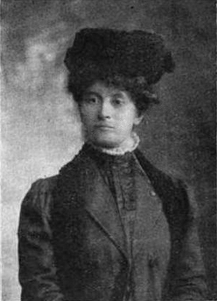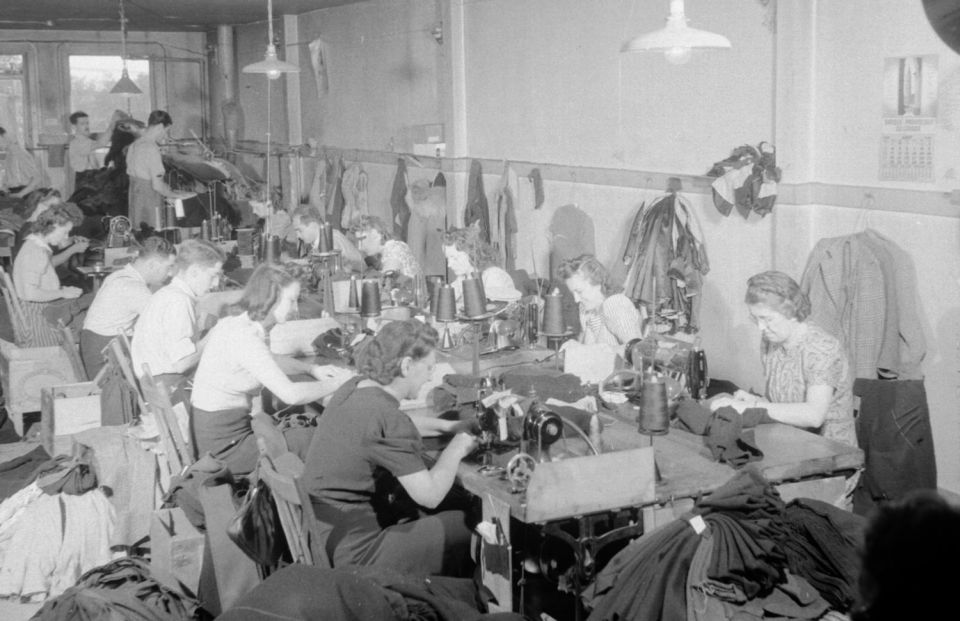|
Cloakmaker
A Cloak maker worked in the garment industry, often in an enterprise whose workers were represented by a union. In the 1920s, there were more than 50,000 people employed as ''cloakmakers''. Much of this industry was centered in NYC. While most of the cloakmakers were Jewish women, the next largest group, although much smaller in number, were Italian women. Cloakmakers were a part of those known as clothing-workers, including those who made cloaks, suits and skirts. Other areas where this industry was strong included Chicago and Cincinnati. Unions Suffragist Theresa Malkiel Theresa Serber Malkiel (1 May 1874 – 17 November 1949) was an American labor activist, suffragist, and educator. She was the first woman to rise from factory work to leadership in the Socialist party. Her 1910 novel, ''The Diary of a Shirtwaist ... organized a union of cloakmakers in 1892. Other areas of the ''needle trade'' were not unionized until years later, of whom in 1912 over 80% were Jewish. Th ... [...More Info...] [...Related Items...] OR: [Wikipedia] [Google] [Baidu] |
Theresa Malkiel
Theresa Serber Malkiel (1 May 1874 – 17 November 1949) was an American labor activist, suffragist, and educator. She was the first woman to rise from factory work to leadership in the Socialist party. Her 1910 novel, ''The Diary of a Shirtwaist Striker'', is credited with helping to reform New York state labor laws. As head of the Woman's National Committee of the Socialist Party of America (SPA), she established an annual National Woman's Day which was the precursor to International Women's Day. In 1911, while on a speaking tour of the American South, she called attention to the problem of white supremacism within the party. She spent her later years promoting adult education for women workers. Early life Theresa Serber was born in Bar, Russian Empire (now Ukraine) on May 1, 1874, one of seven sisters. Serber and her family were Jewish, and persecuted in Russia, so they emigrated to the United States, settling in Lower East Side of New York City in 1891, and seventeen-ye ... [...More Info...] [...Related Items...] OR: [Wikipedia] [Google] [Baidu] |
Cloak
A cloak is a type of loose garment worn over clothing, mostly but not always as outerwear for outdoor wear, serving the same purpose as an overcoat, protecting the wearer from the weather. It may form part of a uniform. Cloaks have been and are worn in countless societies. Over time cloak designs have been changed to match fashion and available textiles. Cloaks generally fasten at the neck or over the shoulder, vary in length, from hip all the way down to the ankle, mid-calf being the normal length. They may have an attached hood and may cover and fasten down the front, in which case they have holes or slits for the hands to pass through. However, cloaks are almost always sleeveless. Etymology The word ''cloak'' comes from Old North French ''cloque'' ( Old French ''cloche'', ''cloke'') meaning "travelling cloak", from Medieval Latin ''clocca'' "travelers' cape," literally "a bell," so called from the garment's bell-like shape. Thus the word is related to the word ''clock ... [...More Info...] [...Related Items...] OR: [Wikipedia] [Google] [Baidu] |
The New York Times
''The New York Times'' (''the Times'', ''NYT'', or the Gray Lady) is a daily newspaper based in New York City with a worldwide readership reported in 2020 to comprise a declining 840,000 paid print subscribers, and a growing 6 million paid digital subscribers. It also is a producer of popular podcasts such as '' The Daily''. Founded in 1851 by Henry Jarvis Raymond and George Jones, it was initially published by Raymond, Jones & Company. The ''Times'' has won 132 Pulitzer Prizes, the most of any newspaper, and has long been regarded as a national "newspaper of record". For print it is ranked 18th in the world by circulation and 3rd in the U.S. The paper is owned by the New York Times Company, which is publicly traded. It has been governed by the Sulzberger family since 1896, through a dual-class share structure after its shares became publicly traded. A. G. Sulzberger, the paper's publisher and the company's chairman, is the fifth generation of the family to head the p ... [...More Info...] [...Related Items...] OR: [Wikipedia] [Google] [Baidu] |
Cloak Makers Parade, 1916 LCCN2014702121
A cloak is a type of loose garment worn over clothing, mostly but not always as outerwear for outdoor wear, serving the same purpose as an overcoat, protecting the wearer from the weather. It may form part of a uniform. Cloaks have been and are worn in countless societies. Over time cloak designs have been changed to match fashion and available textiles. Cloaks generally fasten at the neck or over the shoulder, vary in length, from hip all the way down to the ankle, mid-calf being the normal length. They may have an attached hood and may cover and fasten down the front, in which case they have holes or slits for the hands to pass through. However, cloaks are almost always sleeveless. Etymology The word ''cloak'' comes from Old North French ''cloque'' (Old French ''cloche'', ''cloke'') meaning "travelling cloak", from Medieval Latin ''clocca'' "travelers' cape," literally "a bell," so called from the garment's bell-like shape. Thus the word is related to the word ''clock''. Hi ... [...More Info...] [...Related Items...] OR: [Wikipedia] [Google] [Baidu] |
Suffragist
Suffrage, political franchise, or simply franchise, is the right to vote in public, political elections and referendums (although the term is sometimes used for any right to vote). In some languages, and occasionally in English, the right to vote is called active suffrage, as distinct from passive suffrage, which is the right to stand for election. The combination of active and passive suffrage is sometimes called ''full suffrage''. In most democracies, eligible voters can vote in elections of representatives. Voting on issues by referendum may also be available. For example, in Switzerland, this is permitted at all levels of government. In the United States, some states such as California, Washington, and Wisconsin have exercised their shared sovereignty to offer citizens the opportunity to write, propose, and vote on referendums; other states and the federal government have not. Referendums in the United Kingdom are rare. Suffrage is granted to everybody mentally capable, ... [...More Info...] [...Related Items...] OR: [Wikipedia] [Google] [Baidu] |
Fannia Cohn
Fannia Mary Cohn (April 5, 1885 – December 24, 1962) was a leading figure in the International Ladies' Garment Workers' Union (ILGWU) during the first half of the 20th century. She is remembered as one of the pioneers of the workers' education movement in the United States and as a prolific author on the theme of trade union education. Biography Early years Fannia Mary Cohn was born on April 5, 1885 to an ethnic Jewish family in Kletsk, Belarus, then part of the Russian empire.Daniel Katz, ''All Together Different: Yiddish Socialists, Garment Workers, and the Labor Roots of Multiculturalism.'' New York: New York University Press, 2011; pg. 49. She was the fourth of five children of a successful owner of a flour mill and his wife.Huey B. Long and Constance Lawry"Fannia Mary Cohn: An Educational Leader in Labor and Workers' Education, Her Life and Times," in Rae Wahl Rohfeld (ed.), ''Breaking New Ground: The Development of Adult and Workers' Education in North America.'' Syracuse ... [...More Info...] [...Related Items...] OR: [Wikipedia] [Google] [Baidu] |
Fur Coat
Fur clothing is clothing made from the preserved skins of mammals. Fur is one of the oldest forms of clothing, and is thought to have been widely used by people for at least 120,000 years. The term 'fur' is often used to refer to a specific item of clothing such as a coat, wrap, or shawl made from the fur of animals. Humans wear fur garments to protect them from cold climates and wind chill, but documented evidence of fur as a marker of social status as far back as 2,000-years ago with ancient Egyptian emperors and high priests wearing the skins of leopards. Historically in European and Middle Eastern cultures fur garments often had the fur facing inwards with cloth on the exterior of the jacket, but in the 19th century a trend for wearing seal fur coats with the fur facing outwards became the trend. World wide both styles are popular, with fur linings offering more thermal benefits and exterior furs serving more of a fashionable purpose. History Fur is generally tho ... [...More Info...] [...Related Items...] OR: [Wikipedia] [Google] [Baidu] |
Manufacturing
Manufacturing is the creation or production of goods with the help of equipment, labor, machines, tools, and chemical or biological processing or formulation. It is the essence of secondary sector of the economy. The term may refer to a range of human activity, from handicraft to high-tech, but it is most commonly applied to industrial design, in which raw materials from the primary sector of the economy, primary sector are transformed into finished goods on a large scale. Such goods may be sold to other manufacturers for the production of other more complex products (such as aircraft, Major appliance, household appliances, furniture, sports equipment or automobiles), or distributed via the tertiary industry to end users and consumers (usually through wholesalers, who in turn sell to retailers, who then sell them to individual customers). Manufacturing engineering is the field of engineering that designs and optimizes the manufacturing process, or the steps through whic ... [...More Info...] [...Related Items...] OR: [Wikipedia] [Google] [Baidu] |
Clothing Industry
Clothing industry or garment industry summarizes the types of trade and industry along the production and value chain of clothing and garments, starting with the textile industry (producers of cotton, wool, fur, and synthetic fibre), embellishment using embroidery, via the fashion industry to apparel retailers up to trade with second-hand clothes and textile recycling. The producing sectors build upon a wealth of clothing technology some of which, like the loom, the cotton gin, and the sewing machine heralded industrialization not only of the previous textile manufacturing practices. Clothing industries are also known as allied industries, fashion industries, garment industries, or soft good industries. Terminology By the early 20th century, the industry in the developed world often involved immigrants in " sweat shops", which were usually legal but were sometimes illegally operated. They employed people in crowded conditions, working manual sewing machines, and being paid ... [...More Info...] [...Related Items...] OR: [Wikipedia] [Google] [Baidu] |



.png)


_(cut).jpg)

